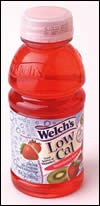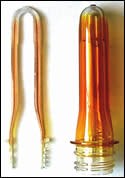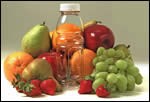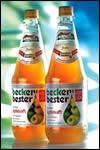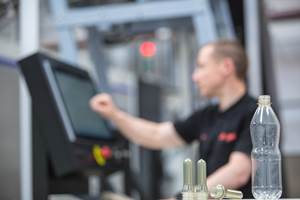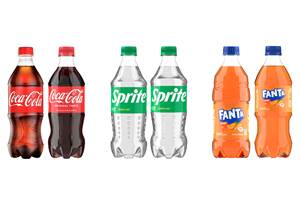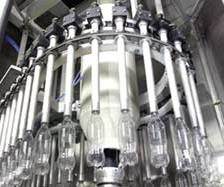Barrier Bottle Technologies Square Off
With single-serve containers raising shelf-life demands, packagers are seeking the barrier with the best cost-performance for PET bottles. Multilayer seems to have the upper hand, but monolayer, coating, and oxygen-scavenger technologies have all won niches.
The race to develop the most cost-effective PET bottle barrier technology has moved into high gear. Growing worldwide demand for single-serve containers has given new urgency to the search for barrier solutions. Resin makers and other suppliers have unveiled a host of new alternatives—new barrier resins and oxygen scavengers, more economical surface coatings, high-output multilayer preform molding systems, and novel monolayer solutions.
The consensus among industry observers is that no clear winner has emerged among the three contenders (multilayer, monolayer, and coatings). Container size, shelf-life requirements, and other performance needs are so diverse that no one barrier option fits the bill across the board. "They're all doing a good job of 'niche-ing' these materials and technologies and fitting them in appropriate applications," says John Jones, PET bottle team leader for resin maker Honeywell Performance Products. A recent study by coinjection systems supplier Kortec Inc. and consultant SBA-CCI WorldPET in Atlanta shows that multilayer may be becoming the preferred choice. Around 62% of PET barrier bottles worldwide are multilayer while 25% are monolayer and 13% use coatings, according to the joint research.
The bottom line for food and beverage companies is whether extended shelf life brings greater economic returns, says Gregory Luka, technical director for machine builder Sidel.
This evolutionary period for barrier technologies has yielded a number of important advances. Hopes for a long-sought breakout of PET beer bottles have been rekindled, particularly in Europe; and a rollout of 12-oz PET bottles by leading U.S. carbonated soft-drink makers poses the first credible threat to the 12-oz aluminum can.
Beer takes off
With multilayer technology in place for several years, blow molders had hoped that by now a major conversion to PET would be under way. But only in the last two years has a confluence of events triggered growth in PET beer bottles, mostly in Europe. While many believe the market was ripe for a move into plastic, it was German recycling legislation implemented in 2003 that opened the door wide for PET barrier bottles. The law, which mandated the equivalent of a 25¢ deposit on all one-way containers, had the unexpected consequence of effectively removing aluminum cans from many retail establishments. That's because PET had already achieved very high volume in water and soft drinks, having largely eliminated glass. Then, some retail outlets in Germany refused to establish reclaim streams for all container types and instead set up so-called "island solutions" that accepted only PET containers. So beer companies scurried to get beer into PET bottles.
The new deposit law thus indirectly boosted German consumption of PET beer containers in Germany from 150 million to 1 billion per year, according to Gordon Bockner, president of consulting firm Business Development Associates. In Europe overall, more than 10% of packaged beer now comes in PET, reports Schoenwald Consulting in Germany.
However, these figures include the booming beer market in Russia and Ukraine, much of which uses non-barrier PET bottles in larger 1.5-liter and 2L sizes. Still, PET beer bottles in general have enjoyed significant penetration and 40% growth is forecast for 2005 to 2008, says Dieter Schoenwald, president of Schoenwald Consulting in Germany.
For beer, the challenge of providing a barrier against carbon dioxide egress and oxygen ingress has been met largely by multilayer PET structures along with some use of coatings and barrier-enhanced monolayer bottles. Amcor PET packaging, Ann Arbor, Mich., has been a leader in Europe with its AmGuard multilayer construction, which includes a proprietary Bind-Ox oxygen scavenger that provides a shelf life between 6 and 15 months. Sidel has also been successful in Europe with its Actis barrier coating at brewers such as Martens in Belgium. The Actis system deposits a thin layer of hydrogen-rich carbon on the bottle's inner wall.
Another growth area is Korea, where the two largest brewers are converting from glass to barrier PET. For example, a 1.6L multilayer PET bottle launched by Hite Brewery Co., Korea's largest, reportedly accounts for 15% of beer consumed in South Korea. The bottle, which is said to provide 26-week shelf life, is blow molded by Hyosong Corp. of South Korea. The three-layer preform is produced on a coinjection system from Kortec Inc. The barrier layer is Honeywell's Aegis OXCE nylon-based nanocomposite.
Oriental Brewing, the other major South Korean brewer, uses ActiTuf monolayer PET material from M&G Polymers, which combines a proprietary oxygen scavenger and MXD6 nylon for passive gas barrier in 0.6L to 1.2L bottles. M&G has three classes of ActiTuf materials that combine different levels of passive and active barriers. Initially targeted for beer, ActiTuf grades are also being developed for 12-oz carbonated soft drinks and juices.
Meanwhile, the major U.S. brewers, which have taken a wait-and-see stance, are starting to explore new market opportunities for barrier PET beer bottles. So far, they have been used in limited amounts, mostly in special venues like sports arenas where glass is prohibited. But that's changing. "The beer business is going beyond original distribution patterns focused on venue trade and is finding new ways to position the plastic bottle in the retail market," says Ralph Armstrong, director of global licensing support and business development for Graham Packaging, a major producer of multilayer bottles.
An example is Coors Brewing Co., Golden, Colo., which recently introduced an innovative cooler box that holds 18 plastic bottles. Described as the industry's "first ice-ready bottle pack," the cardboard box comes lined with plastic film so it can hold ice. It carries 16-oz PET bottles that Coors touts as resealable and able to stay cold longer than glass bottles or aluminum cans. The multilayer bottle is the same as previous versions Coors used for special venues. Unlike other brewers that have tried to tap the broader retail market with low-profile attempts to introduce plastic bottles, Coors is backing the new cooler pack with a national advertising campaign, including television spots on ESPN, the cable sports network.
Anheuser-Busch also has unveiled 16-oz multilayer PET bottles for its Budweiser Select and Michelob Ultra brands. While the bottles are positioned for special venues, the brewer says other potential targets include "select off-premises accounts."
Soda cans under attack
Another promising and highly competitive market for PET barrier bottles is carbonated soft drinks (CSD), where the full gamut of technologies is being explored and tested. At the forefront of the latest assault on the 12-oz aluminum can is Kortec, which sold its first 144-cavity PET preform coinjection system to a leading bottle maker for one of the largest CSD companies. Kortec's Ultra 144 coinjection system will produce 20-g, three-layer preforms at up to 250 million/yr. An MXD6 nylon barrier layer provides 20-week shelf life. Up to now, CSD makers have test marketed heavier (28-g) monolayer, 12-oz bottles that had only seven to eight weeks' shelf life. The Ultra 144 uses Kortec tooling and a 600-ton Husky injection machine. The multilayer bottle is being test marketed in selected geographic regions.
Coating technologies such as Sidel's Actis system are also being explored in North America for CSD. Sidel says two companies are using its system for 12-oz and half-liter bottles. And SIG Corpoplast is preparing to install one of its Plasmax 12D barrier coating systems at a leading U.S. bottle maker for CSD. SIG's Plasma Impulse Coating Vapor Deposition (PICVD) system, which applies a silicon oxide coating less than 0.1 microns thick inside PET bottles, reportedly raises the shelf life of 12-oz bottles almost three-fold to more than 25 weeks. It has 12 dual-bottle coating stations that process around 10,000 bottles/hr. The system was developed by SIG and Schott HiCotec, a coating specialist in Mainz, Germany.
Multilayer technology currently appears to have an edge over coatings because it is considered more mature and provides higher output. It has proven itself in PET ketchup and beer bottles. Coating suppliers are trying catch up in output rates. Sidel plans to unveil next year a new Actis machine that will boost output from 12,000 bottles/hr to between 36,000 and 40,000/hr. "This puts us in line with the market to help further convert aluminum cans to plastic," says Sidel's Luka.
After slow progress in CSD and beer, DevTech Labs is now focused on oxygen-sensitive food containers with its hybrid system, which combines coinjection and overmolding to make preforms of five to nine layers. The company is experimenting with a range of oxygen scavengers.
Monolayer makes progress
For processing simplicity and minimal equipment and tooling cost, bottle makers would prefer a monolayer structure for a barrier PET bottle. By blending a barrier resin or oxygen scavenger or both with PET, the need for multilayer coinjection ma chines or coating equipment would be eliminated. One new development in this direction is a high-barrier PET blend that reportedly produces monolayer beer bottles with shelf life of three to six months that withstands tunnel pasteurization. As we reported in June, Futura Polyesters in India developed the bottle from a new blend of PET and PTN (polytri methylene naphthalate). PTN, which is based on Corterra PTT technology licensed from Shell Chemical, reportedly has 18 times the CO2 barrier of PET and 3.5 times that of polyethylene naphthalate (PEN). PTN's O2 barrier is nine times greater than PET's and about twice that of PEN.
Stretch-blown half-liter bottles of the blend reportedly show twice the CO2 barrier of PET. PTN also provides heat resistance, so bottles can take tunnel pasteurization (more than 30 min at 60 C) without neck crystallization. Futura says PET/PTN beer bottles cost the same as glass. Four major Indian brewers are evaluating the bottles.
Constar In ter na tional in Philadelphia, a maker of multilayer bottles based on its Oxbar three-layer barrier system used widely in beer, believes the future for noncarbonated products lies in monolayer solutions, according to marketing manager Paul Prinko. "Mo no layer brings important advantages like lower investment cost, production flexibility, and design freedom," he says.
Constar already has a monolayer system, called Monoxbar, which incorporates a proprietary O2 scavenger for single-serve food and beverage containers for juices, teas, ketchup, and "enhanced waters." The company is seeking FDA approval for a new "breakthrough" monolayer system, called DiamondClear, which reportedly offers the same clarity as standard PET. The product meets a need for a barrier bottle with glass-like clarity for single-serve juices, teas, and tomato-based products. DiamondClear provides greater clarity than competitive monolayer systems, Constar claims.
PolyShield, a modified PET from Invista (formerly KoSa), provides a monolayer option with 15% greater CO2 barrier plus oxygen ingress of less than 1 ppm/yr. The PET, which includes a special compatibilizer and catalyst, is intended to be mixed in the blow molding machine barrel with MXD6 nylon from Mitsubishi Gas Chemical. The material is targeted for beer and juice bottles, mostly in Eastern Europe and South America. Invista is working on grades with improved passive barrier and uv protection for clear beer bottles.
Wellman has developed a special PET grade with a proprietary chemistry for blending with up to 4% MXD6 nylon in the molding machine. Called HP867, it is designed to make clear monolayer CSD containers that meet shelf-life requirements for 12- to 16-oz bottles. Slated for commercialization later this year, HP867 is still pending FDA approval, notes Dave Russell, market development manager.
Monolayer and multilayer PET containers have also been aided by Amosorb DFC 4020, a polyester-based oxygen-scavenger additive developed by BP Amoco (now Innovene), which has found commercial success in the U.S., Europe, and Asia. It offers increased shelf life for oxygen-sensitive beverages such as juice, beer, wine, and tea. The oxygen-scavenging technology was licensed in 2003 to Colormatrix, which supplies a pellet masterbatch to be added during molding. This allows the scavenger level to be varied to match the required level of oxygen barrier.
Amcor uses Amosorb DFC 4020 in its Amfresh monolayer containers for single-serve juices and Graham Packaging uses it in its Monosorb monolayer juice bottles. Colormatrix' newest offering is Amosorb LCA, which includes a low-color additive package to reduce yellowing in recycled PET by 30%. Other products in development include Amosorb with a uv blocker and Amosorb with amber colorant plus uv blocker for monolayer and multilayer beer bottles.
More material options
Nanocomposites are a newer option for barrier bottles. One of these is Imperm nanoclay/MXD6 nylon blend for use as a barrier layer in multilayer PET bottles. Developed by Mitsubishi Gas Chemical and Nanocor Inc., the nanoclay supplier, Imperm is said to offer greater oxygen and CO2 barrier than straight MXD6 nylon. It is being used commercially in Europe in 350-cc bottles for flavored alcoholic beverages.
Oxygen scavenging technology also continues to proliferate. Valspar has developed a series of proprietary thermoplastic scavenging materials called Valor that are compatible with PET for monolayer or multilayer barrier bottles. Valspar is targeting 0.5L juice, beer, and food bottles. The material's key attributes are moisture activation of oxygen scavenging and excellent delamination resistance in multilayer uses compared with other barrier materials like MXD6 nylon. Valor also maintains its O2 scavenging performance in hot, humid conditions (90 F and 90% RH). Valor comes in three grades: one for monolayer use and two with varied active/passive barriers for multilayer CSD and beer bottles.
Another new polymeric additive to improve delamination resistance of multilayer bottles has been developed by Kortec in partnership with materials developer Steripak Ltd. in Australia. Called a "fractal polymer" because of its ultra-high specific surface area (about 100,000 times more surface area per gram than nylon powder), it is also porous, both of which factors contribute to easy mixing with nylon barrier resin. This additive is added at 2.5% levels to MXD6 at the molding machine. It significantly reduces delamination without a loss of barrier properties and broadens the processing window, according to Kortec president Paul Swenson. In a 6-ft drop test, straight MXD6 nylon exhibits 20% delamination while additive-enhanced MXD6 has no delamination, claims Swenson. The additive is sold by Kortec in the U.S. and Europe. Current U.S. applications include CSD bottles.
Honeywell says its Aegis MXD6 barrier for multilayer containers offers better delamination resistance than competitive grades. The company offers three grades that are tailored for beer, CSD, and hot-fill applications. Two of the three (for beer and hot-fill uses) incorporate active scavenging systems.
PEN finds a niche
PEN, a heat-resistant, higher-barrier cousin of PET, has struggled to find widespread adoption in single-serve containers due to its high cost. However, the material recently has found a successful niche in multi-trip, returnable/refillable beer and juice bottles in Scandinavia and South America because it withstands high heat and repeated washing. Rexam Petainer, a div. of British-based Rexam PLC (U.S. headquarters in Chicago), has launched its fifth PEN beer bottle (the first was in 1999 and is still on the market). Foroya Bjor in the Danish Faroe Islands is using a 0.38L refillable PEN bottle for its beer brands. The bottle weighs 36 g and is intended for reuse up to 20 times. Rexam claims to be the world's leading producer of PEN bottles and the first and only one to develop refillable PEN bottles.
Rexam achieved similar success with 1L hot-fill, refillable bottles for fruit juices from Beckers Bester in Germany. The bottle is fillable at up to 80 C and can be washed at the same temperature as glass. PEN's barrier properties enable beer to be stored without refrigeration.
Rexam is targeting PEN containers for brewers who prefer a refillable alternative to glass. Rexam is also following developments in blends, according to Ulf Dackemark, sales and marketing manager. He says monolayer blend solutions like Invista's PolyShield and M&G's ActiTuf have been successful in Eastern Europe. In Western Europe multilayer and coating solutions are preferred due to beer shelf-life demands, according to Dackemark.
Coatings fight for position
The list of barrier coating technologies has been pared down with the elimination of systems from Krones AG in Germany and Tetra Pak in Vernon Hills, Ill. Krones BestPET technology, co-developed with Coca-Cola, deposited a silicon-oxide barrier on the bottle exterior. A company spokesman said the technology was dropped because of cost issues and inadequate O2 barrier. Tetra Pak's discontinued Glaskin coating was a silicon-dioxide plasma-coating system for the interior of PET bottles.
Meanwhile, SIPA of Italy has developed a new barrier dip coating for PET bottles, called Smart Coat. After blowing, the bottles are dip coated and then flash-dried in an infrared oven. A second coating is applied and then the bottle is uv cured. The stand-alone dip-coating unit can handle about 12,000 bottles/hr. Shelf life for single-serve 0.5L bottles is said to be a year for coated PET vs. seven weeks uncoated. CSD bottles are one target.
Another new entry, developed by Advanced Plastics Technologies (APT) in the U.K., utilizes a proprietary water-based flow-coating process to cover the exterior of preforms with a special thermoplastic barrier resin. After coating, the resin cures and the preforms can be stretch-blown on standard equipment. The CO2 barrier is three to four times that of uncoated PET, and O2 barrier is two to three times greater, claims APT. Husky is under license from APT to make the coating machine, which reportedly can coat around 30,000 preforms/hr. APT director Robert Lee said the process has been licensed to a leading beverage company for packaging of nonalcoholic drinks.
Another new development in exterior coatings comes from the Institute of Plastics Processing (IKV) at RWTH Aachen University in Germany, which licensed its patented plasma PECVD interior coating technology to Sidel. The IKV's new exterior coating system, which applies a 20- to 150-nanometer barrier layer, is similar to the version that applies an interior coating. It offers four times the CO2 barrier of uncoated PET. The system has a 15-sec cycle time and output of 10,000 bottles/hr. Researchers aim to reduce cycle time below 10 sec by employing more powerful vacuum pumps and other minor modifications.
Related Content
Services to Help Blow Molders Convert to rPET
Sidel launches “RePETable” range of services as “one-stop” solution to efficient adoption of rPET for bottle production.
Read MoreFor Extrusion and Injection-Blow Molders, Numerous Upgrades in Machines and Services
Uniloy is revising its machinery lines across the board and strengthening after-sales services in tooling maintenance, spare parts and tech service.
Read MoreCoca-Cola’s Redesign of Small PET Bottles Pushes Lightweighting Below Prior ‘Floor’
Coca-Cola thought it had reached the limits of lightweighting for its small PET carbonated soft drink bottles. But a “complete redesign” led to a further 12% reduction.
Read MoreAll-Electric Shuttle and Stretch-Blow Machines
NPE2024: Meccanoplastica shows off a double-sided shuttle for containers up to 5 L and a reheat stretch-blow molder for up to 2.5 L PET containers with four cavities — both all-electric.
Read MoreRead Next
Barrier PET Bottles
No Breakthrough in Beer, But Juice & Soda Surge Ahead
Read MoreFor PLASTICS' CEO Seaholm, NPE to Shine Light on Sustainability Successes
With advocacy, communication and sustainability as three main pillars, Seaholm leads a trade association to NPE that ‘is more active today than we have ever been.’
Read MoreSee Recyclers Close the Loop on Trade Show Production Scrap at NPE2024
A collaboration between show organizer PLASTICS, recycler CPR and size reduction experts WEIMA and Conair recovered and recycled all production scrap at NPE2024.
Read More
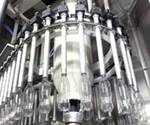


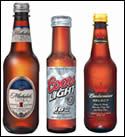
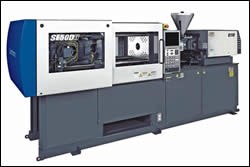
%20system.gif;width=860)
%20system.jpg;width=860)
